Cats and cats need to choose correctly not only toys and other similar accessories, but also blankets. These things are required for the pet in the postoperative period, especially when it comes to abdominal operations associated with the abdominal cavity. Today we will find out what varieties of blankets exist, and how to choose them correctly for cats and cats.
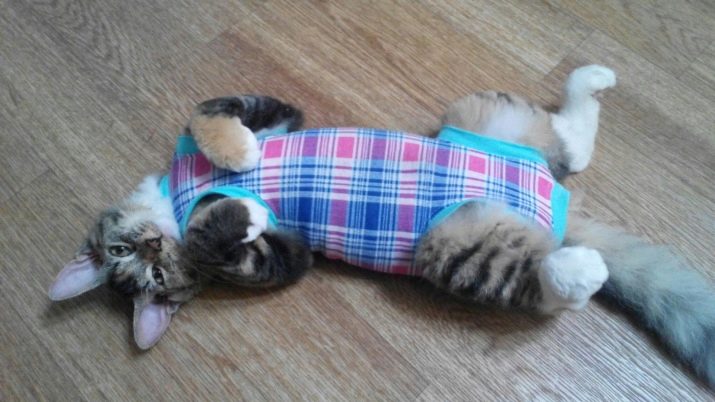
Features
Body cloth is a very useful thing that animals need after various operations. Such medical bandages easily cover the wound left on the body of a cat or cat. In addition, it is necessary to take into account the fact that after carrying out an operation, the animal may be irritated by painful sensations, and it will begin to give unnecessary attention to the area affected during the procedure: nibble, bite or scratch. From these adverse effects, too, will protect the blanket - she will close the cat to the remaining seam.
The main purpose of blankets is to protect the operated area from the ingress of dangerous pathogenic bacteria and infectious microflora. In addition, a quality blanket will cover the seam from the negative effects of sunlight. Mechanical damages with a blanket will also be less likely and dangerous.
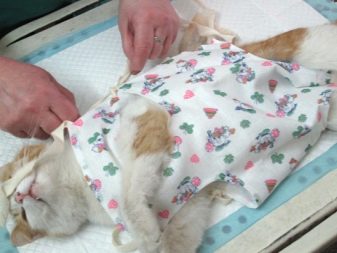
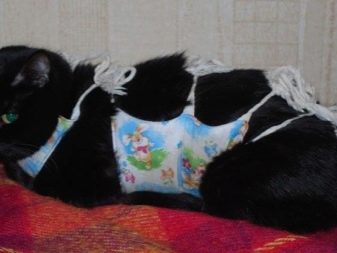
The blanket easily connects with each other the remaining edges of the wound on the body of the pet. Thanks to this, healing takes place faster at the first pull. The regeneration process will noticeably accelerate, and the cat will suffer less from an unpleasant postoperative period. Reserves of the body of the animal will be spent slightly.Properly made and fixed blanket does not allow the muscle walls of the abdominal cavity to stretch or weaken too much. Due to this, further sagging of the cat’s abdomen is prevented.
Blankets can not only be purchased at a veterinary pharmacy or from a veterinarian, but also made with your own hands. Of course, in this case it will be necessary to observe all the nuances and structural features of this thing. The blanket is different in that it can be slightly untied if the wound needs to be treated. In this case, it is not necessary to completely remove it.
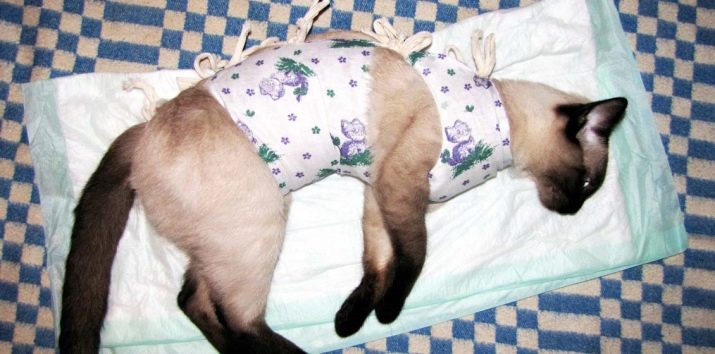
The main advantages of ready-made blankets for cats are the following important points:
- such products are environmentally friendly and do not adversely affect the health and general condition of the operated animal;
- differ in good strength properties - it is very difficult to break them;
- such products pass air well, and this is simply necessary for the healing suture;
- have simple and convenient hook and loop fasteners or zippers.
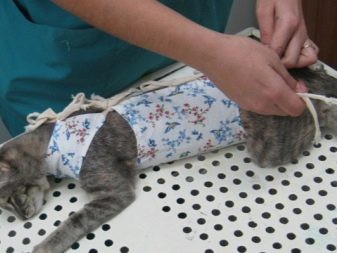
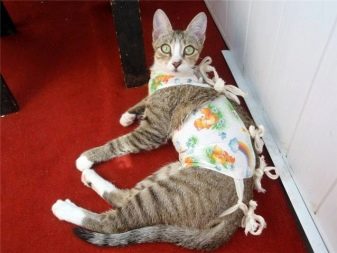
Kinds
Do not think that blanket is the only type of medical bandage. In fact, there are several varieties of it. Different types of blankets differ in their features and design. Get to know them better.
Warm
Cats, which are representatives of hairless breeds, often freeze when outside the window are cold seasons. This not only gives pets significant discomfort, but can also lead to the development of colds. In such circumstances, a special solution will be a special warm blanket. Most often, caring owners of sphinxes and cornish rexes turn to such things. Such types of blankets outwardly look like simple sleeveless jackets.
The best and most comfortable are warm blankets made from soft fabric with a big pile. Such things effectively protect hairless or short-haired cats from low temperatures and cold gusts of wind. Even during the walk the pet will be warm and comfortable in a cozy blanket.
Separately, it is worth highlighting knitted woolen blankets that fit the body well. These specimens are especially warm and have excellent warming effect. In them, cats and cats are very comfortable.

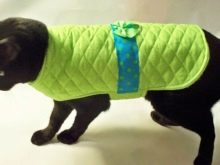
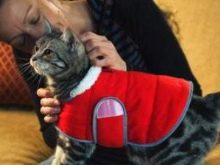
Knitted woolen blankets can easily become an excellent substitute for cat fur.
Homemade
Among cats and cats there are a lot of individuals that suffer from allergic shedding. In this case, the owners constantly have to vacuum the furniture in the house, but this is only a temporary measure - soon all surfaces are again covered with hairs that have fallen from the body of the pet.
In such situations, many people look at hairless cats, mistakenly believing that the lack of hair makes them completely hassle-free. Such individuals have another common ailment - profuse sweating. Because of this, stains can remain on upholstered furniture, which can be very difficult to remove completely.
In the above situations, home blankets can be a real salvation. These products easily and simply absorb the secretions from the body of hairless cats. Losses of wool with such blankets are also noticeably limited. That is why home-made products are so popular and in demand today. However, most homemade blankets still belong to the category of interesting animal wardrobe items.
There are instances that need regular care for all kinds of incurable diseases.
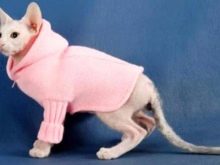

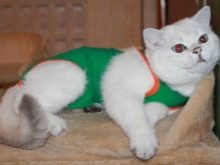
Raincoats
Walking with the animal on the street in cloudy weather, you should stock up on a small rain cover for your pet. Similar models, as a rule, have a hood and fasten under the neck and belly of a cat. Raincoats are sewn from special water-repellent fabrics, such as nylon or vinyl chloride. Polyamide fiber of saturated colors in its properties and characteristics is in no way inferior to a transparent film. If suddenly a downpour begins, the animal in such a cloak will only wet its paws.

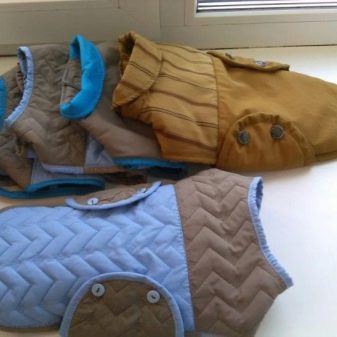
Postoperative
Initially, after various operations, cats wore a special Elizabethan collar. It was a large cone, which was fixed on the neck of the animal and did not allow him to reach the wound. Of course, such things disturbed pets very much and caused unnecessary stress. In addition, pets in such collars could not wash their faces normally, and eating in them was problematic - the edges constantly fought against a bowl, the feed did not always get into the animal's mouth. Moving around the house in such a collar was also problematic, it threatened injury: a cat could cling to furniture, doors or jambs.
It is not surprising that the blanket was a wonderful replacement for this obsolete device. In such a thing, with a zipper or Velcro, the pet can freely move around the house, eat normally, and even play. Although protective mantles may slightly hamper the movements of cats and cats, they still will not prevent pets from leading a normal life. Thanks to this, the recovery process is much easier and faster.
Today, in some European countries, veterinarians still use outdated collars after surgery.
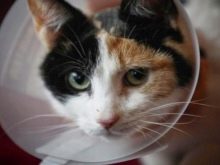
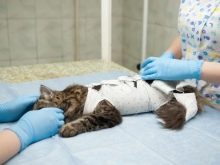
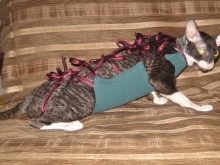
As an alternative, owners are encouraged to wear homemade sleeveless jackets that can be sewn from children's clothing.
Material
Medical varieties of horse blankets for cats are sold in veterinary pharmacies and pet stores. Most often they are made of suitable nonwoven materials. In the specified basis there is no pile, and they do not crumble. Such blankets can be trimmed seamlessly to make it easier for your pet to walk in them. Compressed fibers perfectly absorb liquids. Due to this, the surface of the wound does not get wet and always remains dry, as required.
Non-woven medical blankets also differ in that they do not lend themselves to tearing. Damaging them is quite difficult. They are distinguished by a long service life. Such a blanket is allowed to wash. Such things do not have an aggressive effect on the skin of an animal.
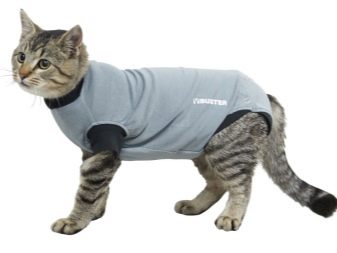
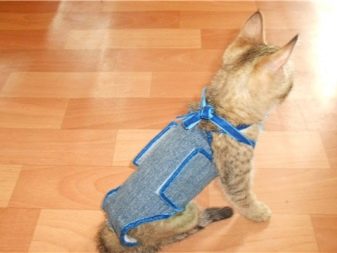
As for factory blankets, they are made from a variety of fabrics, for example:
- cotton;
- viscose;
- spanbond;
- Meltblown.
In order to always have proper air access to the wound, it is recommended to select products made from fabrics of natural origin. Foreign manufacturers very often use a mixture of cotton and lycra. Such materials allow blankets to easily stretch. With such things, cats are less restricted in their movements.
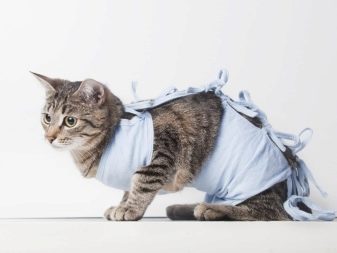
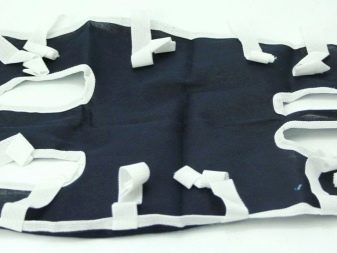
Selection rules
Choosing blankets for cats or cats, for example, after castration or sterilization, must be very carefully and carefully. The following important criteria should be considered.
- Material. Choose postoperative blankets that are made from environmentally friendly and safe materials. This thing must be breathable. It is advisable to buy blankets that easily absorb liquid, so that the wound of the animal always remains dry and not wet.
- Clamps. Track the quality of the fixing parts. Most often, blankets are made with zippers or with Velcro fasteners, as well as simple ties.
- The size. You should choose blankets, the size of which corresponds to the size of the pet itself. It is advisable to make all necessary measurements in advance. You should find out the volume of the cat’s chest, as well as the distance from the base of the shoulders to the tail. Usually all size parameters of blankets are indicated on the package.
- Color. In this case, the color should be paid attention not at all because of its beauty, but practicality. For example, on light materials it will be easier to notice any discharge coming from the wound. In addition, you can easily see that the product is dirty, and it must be sent for washing.
- Workmanship. The blanket should be done right. She must not crawl or slide out of the body of the animal. If this thing is not done as it should, then there will be no sense from it, and it will be difficult to put it on.Sticking and crumbling threads on the material should not be.
- Packaging. It is very important to pay due attention to the branded packaging in which the blanket is sold. This is a thing that will come in contact with the body of the animal and the postoperative suture, so it should be very well sealed.
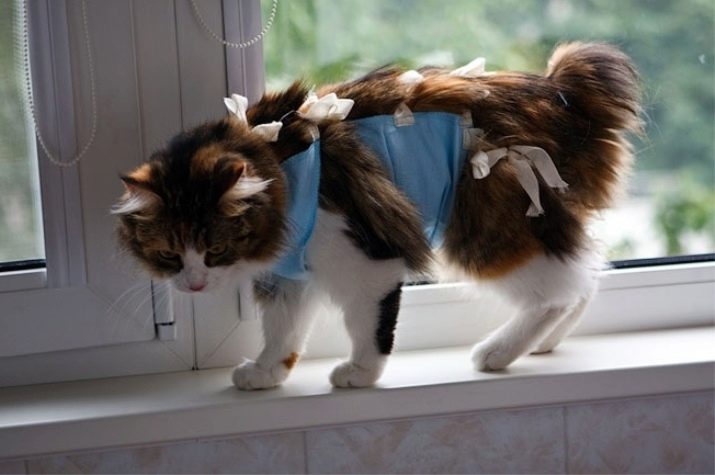
It is advisable to choose options that are sold in fully transparent sealed packaging. In this case, it will be much easier to evaluate all the necessary parameters inherent in things.
If this is not medical, but a home blanket or raincoat, then the choice should be given in favor of products made from high-quality and hypoallergenic materials. If the thing is warm, then it should be soft and comfortable. This can be a fabric with a large pile or natural wool.
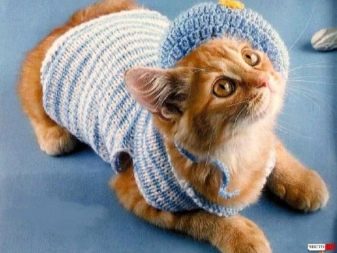
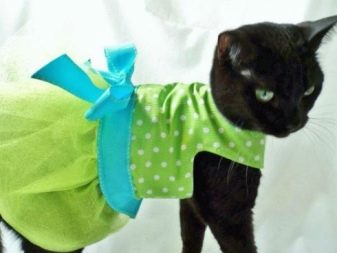
Subtleties of use
Blankets are put on cats immediately after carrying out one or another abdominal operation. In an ideal case, the veterinarian will put this item on the pet for the first time, and then show you how to tie it and remove it on the body. When putting blankets on the body of the pet, extreme caution should be exercised, since postoperative wounds often cause severe pain. The animal will suffer from abrupt and unpleasant movements of the owner. The blanket must be worn on the pet as follows.
- The woven part is required to be attached to the belly of the pet and brought under the front legs. The ribbons should be carefully brought up to the back of the cat.
- Now you need to tie the ribbons in turn. The first and second pairs must be fixed on the neck of the cat to the area where the front legs are located.
- The third pair of ties will need to be carefully fixed behind the legs of the animal, and then connected to the tips of the second pair.
- The fourth and fifth pairs of ribbons are placed on the back of the cat. The latter should be as close to the hind legs as possible.
- As a result, there will remain a pair of ribbons on each side - they will need to be neatly tied together in pairs. In this case, it will be necessary to bend around the thigh of the animal with a ring. The ends of both pairs on both sides will need to be tied together on the back in front of the tail.
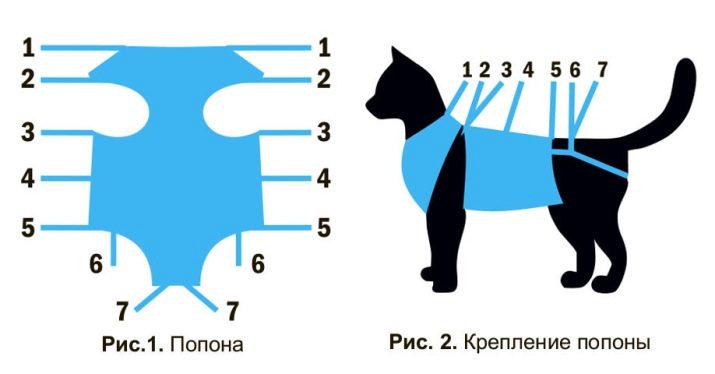
After fixing the blankets it is necessary to ensure that she sits well and does not slip. But this does not mean that it should be tightened with the last forces on the body of the operated pet. Fix the cloak on conscience, but you don’t need to pull it, otherwise the cat will be painful and not comfortable. Adjust the degree of tie tension, if necessary.
For added safety to cats, veterinarians advise tying the ends of ribbons in such a way that they leave a very small free edge. Otherwise, there is a danger of strangulation of the pet with longer ribbons. In addition, you should not leave the animal alone in blankets, because very often cats try to pull off their cloaks in order to lick the wound on their own.
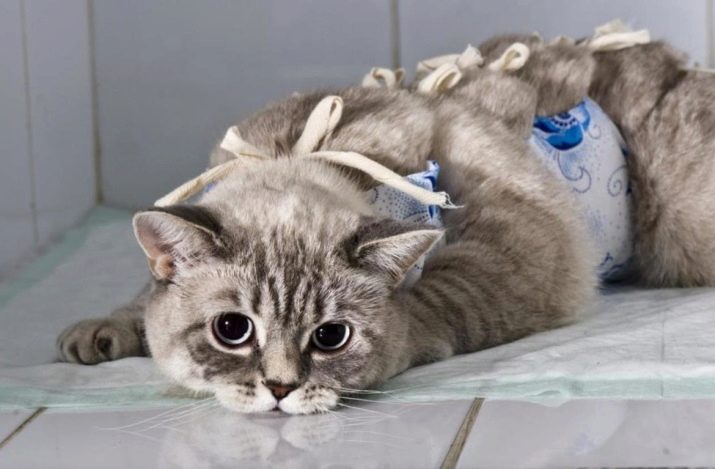
During the first days after the operation, the blanket will need to be changed regularly, especially after the treatment of stitches, which is carried out once a day. As soon as you notice that the wound has begun to heal, and the discharge from it has stopped, the bandage can only be changed as it becomes soiled.
As for the complete rejection of blankets, it will be possible to proceed to this stage only after 10-14 days after sterilization, and not earlier. And it’s worth acting only after consulting with a veterinarian. Usually, all questions can be asked during a routine examination of the pet after the operation.
It is not recommended to act without the knowledge of a specialist if you do not want to accidentally harm your mustachioed friend.
How to do it yourself?
As mentioned earlier, blankets are quite possible to make with your own hands, and not just purchased in a specialized store. So, a good bandage can be independently made from a sock. We will analyze in stages how to do it.
- Take a sock that matches the size of the animal. You can use things from kapron.
- Cut holes in the toe for the paws and tail of the pet. If the neck is too long, then it will need to be shortened.
- Make holes on the back similar to those on sneakers.
- Pass the lace crosswise into the holes made. Try the resulting blanket on the animal and gently tighten.

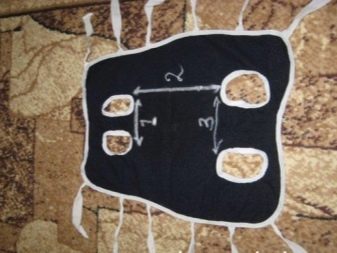
Quickly and simply with your own hands you can make a blanket from tights. This is one of the most affordable options that do not require any special resources. However, it should be borne in mind that using old tights for this is not recommended, since absolute sterility must be observed in postoperative areas.
In addition, it is advisable to find high-density tights. This type of "cover" will be much better to fit the body of the pet, and will last much longer. Such a thing is done elementarily:
- from the selected pantyhose it is necessary to cut a piece with a length of 20 cm;
- then a cut piece is put on the cat’s tummy, and that’s it.
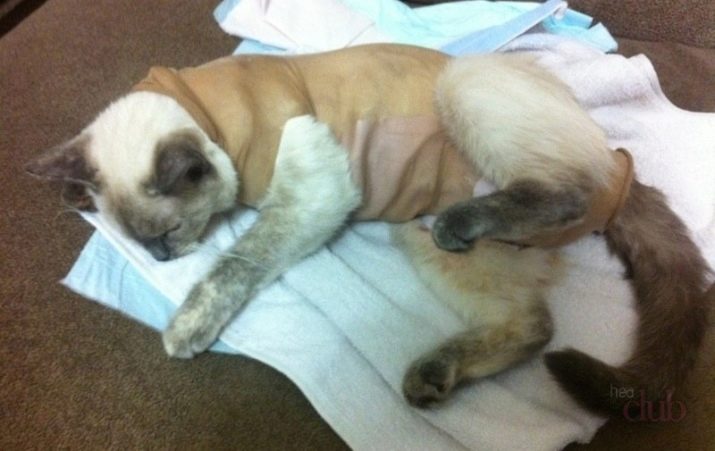
The bandage can also be made from an old T-shirt or a new piece of fabric. If you use brand new material, then in advance you will need to determine some parameters of the pet:
- its length from neck to tail;
- length from neck to shoulder blades;
- from croup to tail;
- neck circumference;
- distance between forelegs;
- girth of the chest;
- girth of the tummy in the groin.
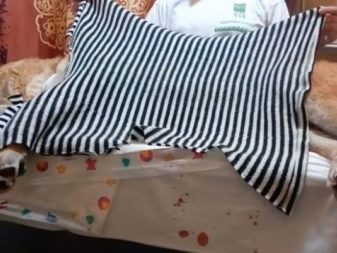
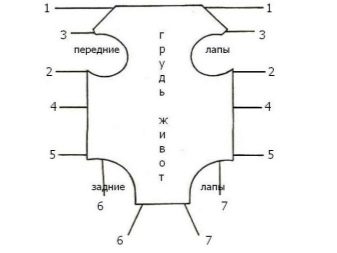
All clarified data should be transferred to a piece of paper, making a schematic drawing of a future product. You will need to leave a small margin - 0.5-1 cm in length to make the ties. Next you need to act like this.
- Transfer all marks made to the prepared piece of fabric. It is advisable to use textiles in two layers to make the blanket more durable.
- Using the prepared scheme, cut out all the necessary details. Fold the allowances and sew on the sewing machine, having previously swept the edges of the thing.
- Next, sew the stitches.
- The resulting product must be tried on a cat to make certain adjustments, if any.
You should pay attention to whether an extra tampon is placed in the abdomen of a cat, because after surgery it can come in handy.
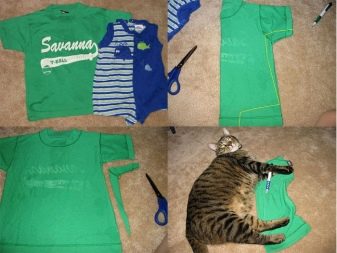
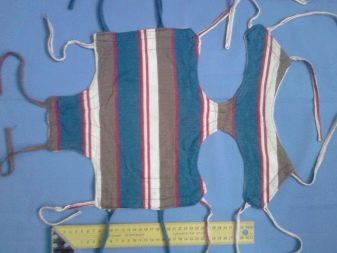
The main advantage of this option is that it is possible to adjust the blanket to a specific structure and characteristics of the pet. True, the time for the manufacture of such a wrap will take much more than a copy of a sock or tights.
Useful Tips
Consider a few useful tips that may come in handy when making or buying blankets.
- If you decide to make a blanket out of fabric, then it is advisable to use a dense and plain material, on which all dirt will be clearly visible. If you notice bloody traces, this will be a signal to immediately visit a veterinarian.
- If you want to use store bandages, it is better to buy two (or maybe more) copies at once, because anything can happen after the operation.
- The length of the blankets must necessarily correspond to the length of the cat's back. As for the width, it should be enough for a full girth of the abdomen. It cannot be too tight.
- If you make a blanket yourself, it is advisable to make the tie ribbons longer. If necessary, they can be shortened.
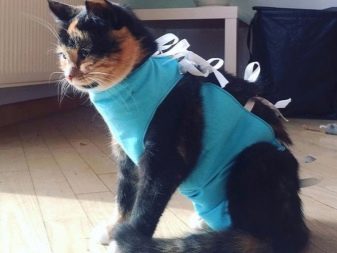
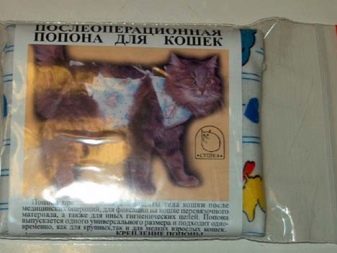
Do not forget to replace the blanket in time or send it to the wash, especially at first. Under no circumstances should the operated animal wear a dirty bandage.
For information on how to make a blanket for a cat from a sock or stocking with your own hands, see the next video.


































